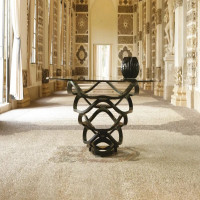Dubbing Materials: Enhancing Your Flies

Fly tying is both an art and a science. It involves careful selection of materials to create lifelike, effective patterns that catch fish. One of the most important materials in fly tying is dubbing. Dubbing is a versatile, soft material that adds texture, colour, and movement to your flies. Whether you're tying a dry fly, a nymph, or even a flashy attractor pattern, the right dubbing can make your fly stand out in the water.
In this article, we’ll explore what dubbing is, the different types available, how to use it, and how the fly tying community, including fans of the perdigonmania style, use dubbing to enhance their flies.
What is Dubbing?
Dubbing refers to small fibres that are either natural or synthetic. These fibres are used to build up the body of a fly, giving it a lifelike shape and appearance. Dubbing is usually applied to the thread and then wrapped around the hook shank to create a fuzzy or smooth body.
It can be fine and smooth for dry flies or rough and spiky for buggy nymphs. The beauty of dubbing is how it can imitate the natural textures found on insects, like legs, gills, or fuzzy abdomens.
Why Dubbing Matters in Fly Tying
Dubbing isn’t just filler—it’s one of the main features of a fly. It determines the fly’s look, feel, and even how it behaves in the water. For example, fine dubbing can keep a dry fly floating, while coarse dubbing creates a buggy appearance that can entice trout to strike.
When matched to the right hook and technique, dubbing brings a fly to life. That’s why even minimalist fly-tying styles, like those seen in the perdigonmania trend, use dubbing strategically to add colour contrast or body shape without making the fly bulky.
Types of Dubbing Materials
There are many types of dubbing materials available, and each has its own strengths. Let’s look at the main categories:
1. Natural Dubbing
Natural dubbing is made from animal fur, such as rabbit, hare, muskrat, or squirrel. These fibres tend to have more variation in length and texture, which makes them perfect for creating buggy and lifelike bodies.
- Hare’s Ear Dubbing is one of the most popular. It’s a blend of soft underfur and guard hairs, making it great for nymphs.
- Rabbit Fur is extremely fine and soft, often used in dry flies and smaller patterns.
- Squirrel Dubbing is coarser and spikier, which adds more texture and movement.
- Natural dubbing absorbs water, which helps nymphs sink, making it an excellent choice for subsurface flies.
2. Synthetic Dubbing
Synthetic dubbing is made from man-made fibres like nylon, antron, or sparkle blends. These fibres can be shiny, translucent, and consistent in texture.
- Antron Dubbing adds a touch of flash and is great for caddis patterns and attractors.
- Ice Dub is a favourite among modern tiers who like to add sparkle to their flies.
- UV Dubbing contains fibres that reflect UV light, helping your fly stand out in low-light conditions.
These synthetic dubbings don’t absorb water easily, which is useful for dry flies and emergers. They also pair well with slim-bodied patterns inspired by perdigonmania, where a bit of shine or colour can make a huge difference.
3. Blended Dubbing
Blended dubbing combines natural and synthetic fibres to get the best of both worlds—bugginess and flash. These blends are ideal for creating versatile patterns that can be used in various water types and conditions.
For example, a Hare’s Ear and Ice Dub blend gives you the natural look of animal fur with a touch of flash that can catch a fish’s eye.
How to Apply Dubbing
Applying dubbing properly takes a little practice, but it’s simple once you get the hang of it. Here are the basic steps:
- Wax the Thread (Optional): Lightly wax your tying thread to help the dubbing stick better.
- Take a Small Amount: A little goes a long way. Start with less than you think you need.
- Twist it on the Thread: Spin the dubbing between your fingers to form a thin, tight noodle.
- Wrap it on the Hook: Wrap the dubbing-covered thread around the hook shank to form the body.
You can adjust the thickness and texture by adding more dubbing or picking out fibres with a dubbing brush or needle to create a buggy appearance.
Dubbing in Nymphs and Perdigon Flies
In nymph patterns, dubbing is often used to mimic the body of underwater insects. A scruffy dubbed body can look like gills, legs, or a natural fuzz that drives trout crazy.
Perdigons flies, popularised by the perdigonmania movement, are known for their slim, fast-sinking profiles. While many perdigon flies use resin-coated thread bodies, some tiers add a tiny dab of dubbing behind the bead or as a thorax to give contrast or imitate legs. This small touch of dubbing doesn’t interfere with the fly’s sink rate but can trigger more strikes.
That’s one reason perdigonmania has influenced dubbing usage. It shows how dubbing doesn’t need to be bulky to be effective—just a small, smart application can make a big impact.
Best Uses for Dubbing by Fly Type
Here’s a quick guide on how dubbing is used in different fly types:
- Dry Flies: Use fine, natural dubbing like superfine rabbit or CDC dubbing. These materials are lightweight and float well.
- Emergers: Use a blend of synthetic and natural fibers to create sparkle and soft silhouettes.
- Nymphs: Coarser dubbing like hare or squirrel gives a realistic, buggy look that imitates underwater insects.
- Attractor Flies: Use bright, flashy dubbing like Ice Dub or UV blends to grab attention.
- Perdigon-style Flies: Keep it minimal. Use smooth thread bodies with just a hint of dubbing for contrast or to imitate legs.
Choosing the Right Colour
Colour selection is also important when using dubbing. Natural colours like olive, brown, grey, and tan work well for imitating real insects. Brighter colours like orange, pink, or chartreuse are better for attractors or hot spots.
In the perdigonmania community, hot spots created with brightly colored dubbing behind the bead have become a trademark. These spots of colour act as triggers that draw the attention of fish, especially in clear or pressured water.
Many tiers experiment with two-tone dubbing—combining a dark body with a light or flashy thorax—to give their flies more contrast. This is another way to blend tradition with innovation, something that the perdigon style has done so well.
Final Thoughts
Dubbing materials are essential for creating effective, versatile, and beautiful flies. Whether you're tying a scruffy hare’s ear, a shiny attractor, or a minimalist fly influenced by perdigonmania, dubbing plays a major role in how your fly looks and performs.
From natural fur to flashy synthetics, the right dubbing adds realism, colour, and motion to your flies. Learning how to use it well will not only improve your fly tying but also your success on the water.
So next time you sit down at your fly-tying bench, grab that bag of dubbing—experiment with textures, try out new blends, and see how just a little bit of fuzzy magic can bring your flies to life.
Note: IndiBlogHub features both user-submitted and editorial content. We do not verify third-party contributions. Read our Disclaimer and Privacy Policyfor details.







